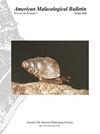水、空气和呼吸过程中马尾松的呼吸生理和心率
IF 0.4
4区 生物学
Q4 MARINE & FRESHWATER BIOLOGY
引用次数: 5
摘要
路易斯安那州的湿地和农作物目前正受到Pomacea maculata的入侵(Perry, 1810)。深入了解壶腹类生物的生理特征对威胁评估、制定有效的控制措施以及加强我们对成功引入入侵物种的生理适应的理解至关重要。本文研究了斑马鱼在水中首次和延长(呼吸)在空气中的呼吸生理和心率。路易斯安那州入侵的斑马鱼拥有功能齐全的肺和鳃,可以在没有水的空气中生存,反过来,也可以在没有空气的水中生存。以V O2为单位测量的水生呼吸速率(~ 19µL/g/h)显著低于斑斑拟合鱼最初的空中呼吸速率(~ 63µL/g/h),而在水中(~ 37 bpm)和最初在空气中(~ 34 bpm)的心率相似。小蜗牛(60克)蜗牛。在空气中呼吸58天后,观察到斑马鱼的心率(86%)、体重(24%)和v02(94%)显著降低。蜗牛在空气中出现时,吸氧率和心律失常有规律地发生周期性变化。本文章由计算机程序翻译,如有差异,请以英文原文为准。
Respiratory Physiology and Heart Rate of Pomacea maculata in Water, Air, and during Aestivation
Louisiana's wetlands and crops are presently under invasion by Pomacea maculata (Perry, 1810). Insight into the physiology of ampullariids is vital to informing threat assessment, developing effective control measures, and enhancing our understanding of the physiological adaptations that facilitate successful introductions of invasive species. This paper addresses the respiratory physiology and heart rate of P. maculata submersed in water, during initial and extended (aestivation) emersion in air. Invasive P. maculata in Louisiana possess fully functional lungs and gills, permitting survival in air without access to water, and reciprocally, survival in water with no access to air. The aquatic respiration rate measured as V O2 (∼19 µL/g/h) was significantly lower than the initial aerial respiration rate (∼ 63 µL/g/h) for P. maculata, while the heart rate was similar in both water (∼37 bpm) and during initial emersion in air (∼34 bpm). Small snails ( 60 g) snails. A substantial reduction in heart rate (86%), body weight (24%), and V 02 (94%) was observed in P. maculata after 58 days of aestivation in air. Periodic changes in the rate of oxygen uptake and cardiac arrhythmia were regularly observed in snails during emersion in air.
求助全文
通过发布文献求助,成功后即可免费获取论文全文。
去求助
来源期刊
CiteScore
1.00
自引率
40.00%
发文量
1
审稿时长
>12 weeks
期刊介绍:
The American Malacological Bulletin serves as an outlet for reporting notable contributions in malacological research. Manuscripts concerning any aspect of original, unpublished research,important short reports, and detailed reviews dealing with molluscs will be considered for publication. Recent issues have included AMS symposia, independent papers, research notes,and book reviews. All published research articles in this journal have undergone rigorous peer review, based on initial editor screening and anonymous reviewing by independent expertreferees. AMS symposium papers have undergone peer review by symposium organizer, symposium participants, and independent referees.

 求助内容:
求助内容: 应助结果提醒方式:
应助结果提醒方式:


